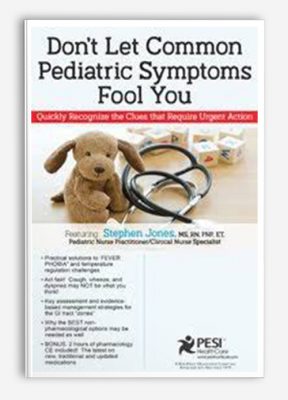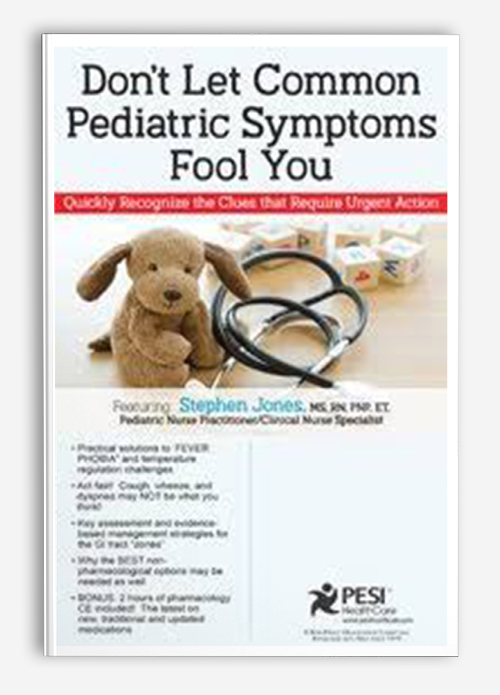Don’t Let Common Pediatric Symptoms Fool You from Stephen Jones
$219.00 $65.00

Don’t Let Common Pediatric Symptoms Fool You Quickly Recognize the Clues that Require Urgent Action from Stephen Jones
Faculty:Stephen Jones |
Duration:6 Hours 36 Minutes | Format:Audio and Video
Archive : Don’t Let Common Pediatric Symptoms Fool You from Stephen Jones
Get Don’t Let Common Pediatric Symptoms Fool You from Stephen Jones on Salaedu.com
Outline:
Assessment: Advanced Skills for Pediatric History-Taking and Physical Assessment
- Developmentally- and age-appropriate techniques for assessment
- Determining cause versus symptom – and underlying triggers
- Non-pharmacological and pharmacological choices
- Laboratory values: System-specific and significance to underlying condition
Best Responses to Early Signs of Acute Respiratory Changes: Recognize and Respond to Early Signs of Distress
- “5 fingered assessment”
- Non-pharmacological: Oxygen therapy, mist/humidification, airway clearance, pulse oximeter, technologies to deliver medications
- Pharmacological choices: OTC versus prescription antimicrobials, “RAD/asthma”, and “cold & cough”
- Apnea: Central and obstructive
- Upper respiratory/ENT conditions: Sinusitis, tonsillitis, croup, laryngomalacia
- Lower respiratory conditions: Infectious (bronchiolitis/RSV and HMV; pneumonia) and anatomical (asthma)
Solve the Complexities of the Pediatric GI Tract
- GI physical examination: Differentiating the “zones” of the GI tract and their functions
- What about the hygiene hypothesis
- Diet and nutrition components: Vitamins, minerals, electrolytes, probiotics
- Underlying triggers: Environmental, infectious, anatomical
- Pharmacological and non-pharmacological management: “Spitting up”, GER and “sensitivities”, colic, constipation
Fever, Temperature and Diarrhea in Children: Avoid the Mis-management Mistakes
- History-taking and physical assessment strategies
- Non-pharmacological and pharmacological: Antimicrobials, antipyretics, anti-diarrheal
- Temperature measurement: Pathophysiology of fever versus hyperthermia and “fever phobia”
- Dehydration: Concepts of fluid and electrolyte management and tonicity
- Diarrhea: Pathophysiology and evidence-based management guidelines (enteral and parenteral)
Get Don’t Let Common Pediatric Symptoms Fool You from Stephen Jones on Salaedu.com
Description:
Children are not small adults, and infants are not small children. Each are unique and require different interventions and treatment modalities. It is imperative that nurses and other healthcare providers in all health care settings – from home to primary to acute care – be prepared to identify and intervene as early as possible with respiratory situations, GI-related conditions, and two of the major maladies of childhood: fever and diarrhea.
As pediatric healthcare providers, it is essential that we grasp and understand the underlying causes of these pediatric clinical challenges. Secondary to both anatomical and physiological etiologies, children with these conditions may present with acute illnesses, flare-ups of chronic conditions or life-threatening complications.
The pediatric patient can present with a myriad of causes contributing to their unexplainable symptoms. Does this sound familiar… Your patient’s parents report increasing symptoms over the past 7 to 10 days. He’s “always been a good sleeper” but his sleep has been impacted now. The little guy is experiencing recurrent fevers, and is seemingly unresponsive to anti-pyretics. He appears restless, “not himself”, and his appetite and fluid intake have been less. While his asthma had been “stable”, he seems to be manifesting increasing symptoms and the albuterol is not helping with the wet cough and is making him gag and “vomit”. Could this case turn south? And how quickly could that happen?
Over the course of this recording, you will learn practical strategies to integrate symptomology and appropriate diagnostics into your differential diagnosis. You will gain an enhanced ability to pinpoint etiology by understanding the inter-relationship of signs/symptoms with new differentiation skills to know when to treat the “cause” versus the “symptom”. You will leave able to intervene quickly and appropriately for the young patients trusted to your care!
1 review for Don’t Let Common Pediatric Symptoms Fool You from Stephen Jones
Add a review Cancel reply
Related products
Internet Marketing Courses
Internet Marketing Courses
Internet Marketing Courses
Internet Marketing Courses
Internet Marketing Courses
Internet Marketing Courses
Internet Marketing Courses
RazorSocial’s – Blogging Blueprint for Success presented by Ian Cleary
Internet Marketing Courses










king –
“We encourage customers to contact Customer Service and think twice before making payment. All course contents will be similar to what is from the author.”
Thank you!